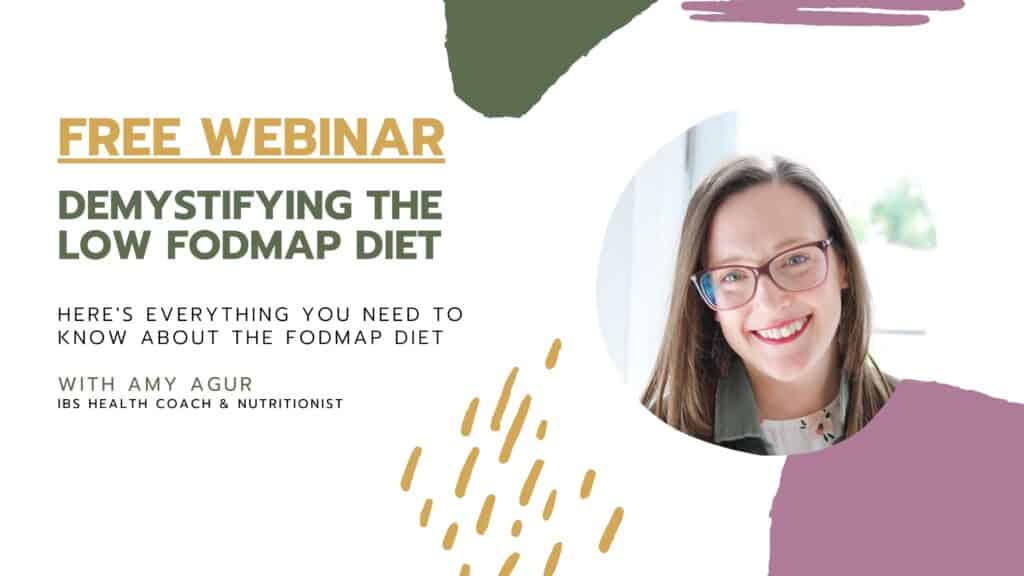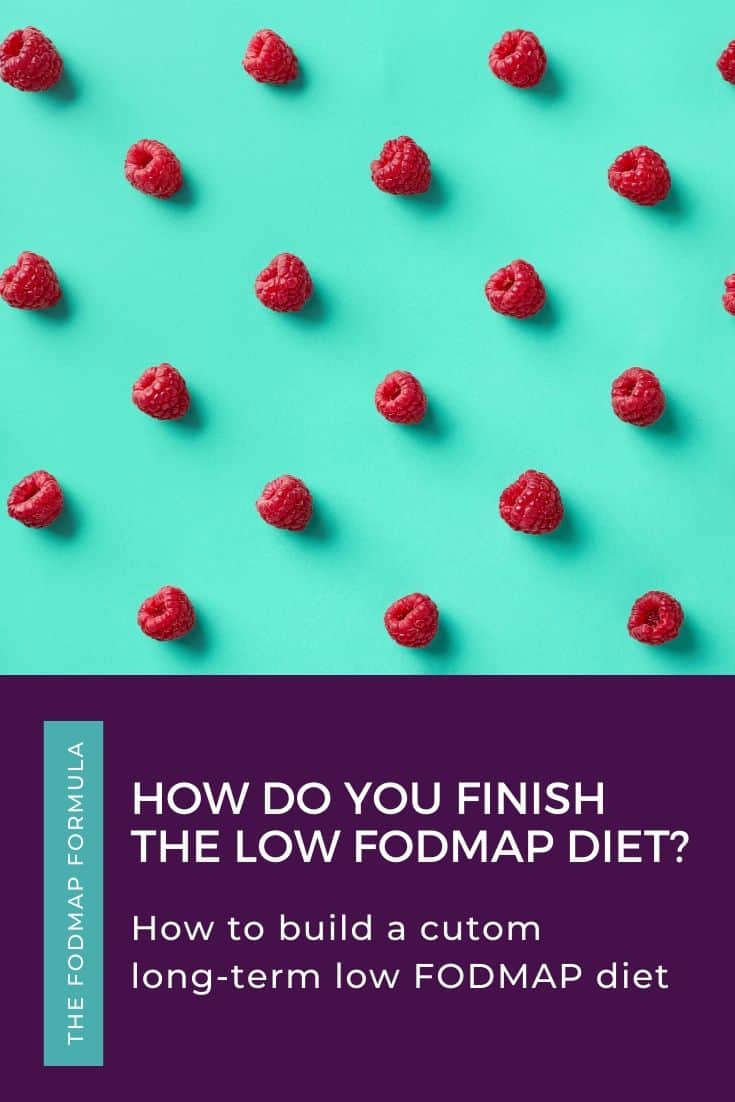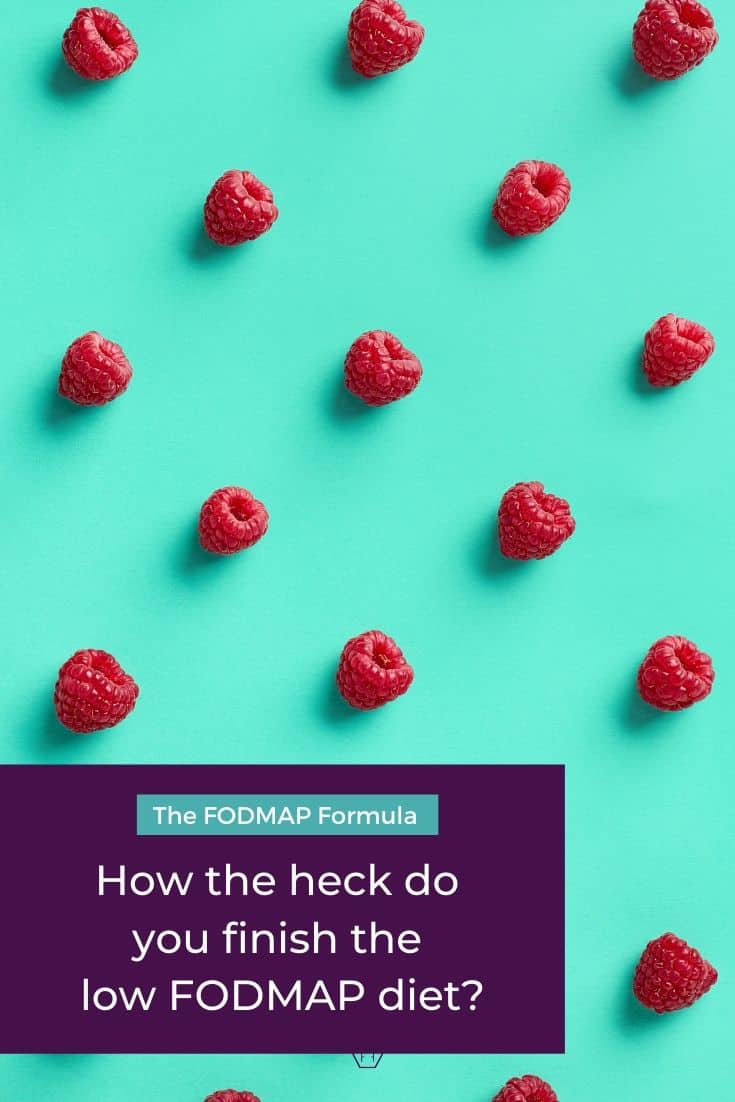Have you ever wondered what happens after the re-challenge phase of the low FODMAP diet? You’re not alone! Check out the article below to find out how to create your customized long-term diet and how to transition out of the low FODMAP program.

Three phases of the low FODMAP diet
While the elimination phase of the low FODMAP program seems to get the most time in the spotlight, the low FODMAP diet is made of three distinct phases.
- elimination
- re-challenge
- personalization
Phase one: elimination
During the elimination phase, all high FODMAP foods are removed from your diet for 2-6 weeks. You’re ready to transition to the next phase when you’ve completed at least two weeks of elimination and your symptoms have been reduced by at least 50% for seven days in a row.
Phase two: re-challenge and reintroduction
Phase two of the low FODMAP program is broken into two parts. During the re-challenge phase, you will test one food from each FODMAP group in increasing amounts over three days, followed by a brief washout period. Each re-challenge will give you a sneak peek of how your body reacts to each FODMAP group.
During the reintroduction phase, you’ll test every high FODMAP food you removed from your diet. Each food you tolerate can stay in your diet from now on.
Foods are typically reintroduced by FODMAP group. This will help you identify patterns in your FODMAP threshold and make it easier to identify groups that should be removed from your diet long-term.
Side note! If you failed a group during the re-challenge phase, you should still test other foods from that group during reintroduction. Just like fat, protein, and carbohydrates, each food has a unique number of FODMAPs.
If you had a reaction to a food with a high number of FODMAPs, you might still tolerate foods with a lower number of FODMAPs from that group. A FODMAP-trained dietitian can help you identify the foods you’re most likely to tolerate from groups that don’t agree with you.
Phase three: FODMAP personalization
Once you’ve determined which high-FODMAP foods you can tolerate, you’re ready to complete the third and final phase, FODMAP personalization. During this phase, you’ll be conducting some experiments to understand how the foods you want to eat fit into your long-term diet. The end result is a custom low FODMAP diet tailored to your unique body.
How to create a personalized low FODMAP diet
To complete the third phase of the low FODMAP diet, you’ll need to do some sleuthing to understand how your body reacts to high FODMAP foods you can tolerate in different portion sizes and combinations. The questions you want to answer are:
- How much of this food can I have on a typical day?
- How many days in a row can I eat this food?
- What else can I combine with this food?
For example, can I have one slice of toast for breakfast? Can I have toast for breakfast and a sandwich for lunch? Can I eat a sandwich every day? Can I eat a sandwich with other high FODMAP foods in it?

How do I practice combining foods?
When creating your customized diet, start by adding one high FODMAP food to one meal per day. This will give your gut a little break between experiments, and help reduce the likelihood that your experiments will stack up in your digestive tract. Once you’ve settled on a few meals that work for you, you can start adding high-FODMAP foods to other meals as well.
Heads up, while you’re learning to mix and match high and low FODMAP foods, you may run into a few combinations your gut doesn’t like. That’s ok, it’s what we’re here for! Just head back to the elimination phase for a few days and try a different combination when you’re feeling better.
For the record, a food journal is invaluable during this phase! By keeping detailed notes on your experiments, you’ll be able to see how your body reacts to different combinations of foods. Having an accurate record will also help you avoid accidentally repeating combinations your body doesn’t like and help you build a database of food combinations and meals you tolerate well.
As you practice different combinations of high and low-FODMAP foods, you’ll develop new habits and patterns of eating. These habits will become your personalized low FODMAP diet.
When you’ve settled into a diet with a healthy mix of high and low FODMAP foods and your symptoms are still stable, you’ve officially transitioned out of the low FODMAP diet.
Does FODMAP tolerance change over time?
Your body and lifestyle will inevitably change over time. Many people find that this can cause changes in their FODMAP tolerance (for worse or for better). Because of this, Monash University and most FODMAP-trained dietitians recommend re-testing your FODMAP tolerance every few years.
While re-testing FODMAPs sounds like a huge pain in the butt, re-evaluating your customized diet regularly may help you add more foods to your diet over time. Plus, keeping an eye on your FODMAP tolerance can help you avoid unnecessary flare-ups if your FODMAP threshold has changed.
Heads up, if you’ve noticed a significant shift in your symptoms or if your symptoms have changed significantly, make sure to schedule a check-in with your healthcare team. While changes in FODMAP tolerance may cause some symptom changes, they can also signal a secondary issue brewing. You’ll want to know which one it is sooner than later.
Final Thoughts
The personalization phase is the third and final phase of the low FODMAP program. During this phase, you’ll have an opportunity to play with different combinations of high and low FODMAP foods and create a customized low-FODMAP diet tailored to your unique body. This unique combination of foods will become your personalized long-term diet.
You might also like one of these:
- Why are your IBS symptoms worse on your period? Wondering why your IBS symptoms always seem worse on your period? Check out this article for everything you need to know about IBS and your period!
- Is your gluten sensitivity really an intolerance to fructans? Gluten isn’t the only thing in your grains that can turn your tummy! Check out this article to understand the difference between gluten and fructan sensitivity and how to find out which one you’re actually reacting to.
- How to cope with IBS related bloating Sometimes, you can do everything right, and things will still go wrong. I interviewed the experts for tips on coping with symptoms when our bodies feel out of our control.
If you like this post, don’t forget to share it! Together we’ll get the low FODMAP diet down to a science!




